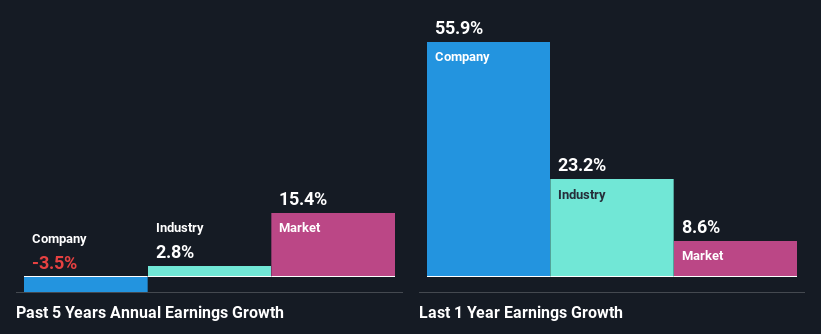Has HNI Corporation (NYSE:HNI) Stock's Recent Performance Got Anything to Do With Its Financial Health?
Most readers would already know that HNI's (NYSE:HNI) stock increased by 5.3% over the past three months. We wonder if and what role the company's financials play in that price change as a company's long-term fundamentals usually dictate market outcomes. In this article, we decided to focus on HNI's ROE.
Return on equity or ROE is an important factor to be considered by a shareholder because it tells them how effectively their capital is being reinvested. In simpler terms, it measures the profitability of a company in relation to shareholder's equity.
Check out our latest analysis for HNI
How Do You Calculate Return On Equity?
Return on equity can be calculated by using the formula:
Return on Equity = Net Profit (from continuing operations) ÷ Shareholders' Equity
So, based on the above formula, the ROE for HNI is:
19% = US$116m ÷ US$606m (Based on the trailing twelve months to October 2022).
The 'return' is the yearly profit. That means that for every $1 worth of shareholders' equity, the company generated $0.19 in profit.
What Is The Relationship Between ROE And Earnings Growth?
We have already established that ROE serves as an efficient profit-generating gauge for a company's future earnings. Based on how much of its profits the company chooses to reinvest or "retain", we are then able to evaluate a company's future ability to generate profits. Assuming everything else remains unchanged, the higher the ROE and profit retention, the higher the growth rate of a company compared to companies that don't necessarily bear these characteristics.
HNI's Earnings Growth And 19% ROE
To begin with, HNI seems to have a respectable ROE. Further, the company's ROE compares quite favorably to the industry average of 13%. Needless to say, we are quite surprised to see that HNI's net income shrunk at a rate of 3.5% over the past five years. Based on this, we feel that there might be other reasons which haven't been discussed so far in this article that could be hampering the company's growth. For example, it could be that the company has a high payout ratio or the business has allocated capital poorly, for instance.
However, when we compared HNI's growth with the industry we found that while the company's earnings have been shrinking, the industry has seen an earnings growth of 2.8% in the same period. This is quite worrisome.
The basis for attaching value to a company is, to a great extent, tied to its earnings growth. What investors need to determine next is if the expected earnings growth, or the lack of it, is already built into the share price. Doing so will help them establish if the stock's future looks promising or ominous. Is HNI fairly valued? This infographic on the company's intrinsic value has everything you need to know.
Is HNI Efficiently Re-investing Its Profits?
HNI's declining earnings is not surprising given how the company is spending most of its profits in paying dividends, judging by its three-year median payout ratio of 68% (or a retention ratio of 32%). With only a little being reinvested into the business, earnings growth would obviously be low or non-existent. You can see the 3 risks we have identified for HNI by visiting our risks dashboard for free on our platform here.
Additionally, HNI has paid dividends over a period of at least ten years, which means that the company's management is determined to pay dividends even if it means little to no earnings growth. Our latest analyst data shows that the future payout ratio of the company over the next three years is expected to be approximately 78%. However, HNI's future ROE is expected to decline to 13% despite there being not much change anticipated in the company's payout ratio.
Conclusion
On the whole, we do feel that HNI has some positive attributes. Yet, the low earnings growth is a bit concerning, especially given that the company has a high rate of return. Investors could have benefitted from the high ROE, had the company been reinvesting more of its earnings. As discussed earlier, the company is retaining a small portion of its profits. Additionally, the latest industry analyst forecasts show that analysts expect the company's earnings to continue to shrink in the future. To know more about the latest analysts predictions for the company, check out this visualization of analyst forecasts for the company.
Have feedback on this article? Concerned about the content? Get in touch with us directly. Alternatively, email editorial-team (at) simplywallst.com.
This article by Simply Wall St is general in nature. We provide commentary based on historical data and analyst forecasts only using an unbiased methodology and our articles are not intended to be financial advice. It does not constitute a recommendation to buy or sell any stock, and does not take account of your objectives, or your financial situation. We aim to bring you long-term focused analysis driven by fundamental data. Note that our analysis may not factor in the latest price-sensitive company announcements or qualitative material. Simply Wall St has no position in any stocks mentioned.
Join A Paid User Research Session
You’ll receive a US$30 Amazon Gift card for 1 hour of your time while helping us build better investing tools for the individual investors like yourself. Sign up here

